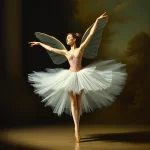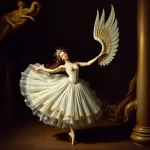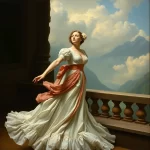Ballet: La Sylphide (Jean-Madeleine Schneitzhoeffer, 1832)

Introduction
La Sylphide is a seminal ballet that premiered in 1832, choreographed by Filippo Taglioni and composed by Jean-Madeleine Schneitzhoeffer. This ballet is often credited with ushering in the Romantic era of ballet, characterized by its ethereal themes and emphasis on the supernatural. The story revolves around a young Scotsman named James, who becomes enchanted by a sylph, a mythical forest spirit, leading to a tragic series of events. The ballet’s premiere took place at the Paris Opera, and it has since become a cornerstone of classical ballet repertoire.
Historical Background
Creation and Development
La Sylphide was created during a period of significant social and artistic change in Europe. The early 19th century saw the rise of Romanticism, a movement that emphasized emotion, nature, and the supernatural. This cultural backdrop heavily influenced the ballet’s themes and aesthetics. The inspiration for La Sylphide came from a story by Charles Nodier, which was adapted into a libretto by Adolphe Nourrit.
The collaboration between choreographer Filippo Taglioni and composer Jean-Madeleine Schneitzhoeffer was crucial to the ballet’s success. Taglioni’s innovative choreography, which included the use of pointe work to create an ethereal, floating effect, was complemented by Schneitzhoeffer’s evocative score. Together, they crafted a ballet that captured the imagination of audiences and critics alike.
Premiere and Reception
La Sylphide premiered on March 12, 1832, at the Paris Opera. The initial reception was overwhelmingly positive, with audiences captivated by the ballet’s innovative choreography and hauntingly beautiful music. The role of the Sylph was performed by Marie Taglioni, Filippo Taglioni’s daughter, whose performance became legendary. Early revivals of the ballet were equally well-received, solidifying its place in the ballet canon.
Synopsis of the Ballet
Act I Summary
The ballet opens in a Scottish farmhouse, where James is preparing for his wedding to Effie. As he dozes by the fireplace, a sylph appears and kisses him, awakening him. James is entranced by the sylph, who vanishes when he tries to touch her. Gurn, another suitor of Effie, witnesses this and becomes jealous. A witch named Madge arrives and predicts that Effie will marry Gurn, not James. Angered, James drives Madge away. The act ends with James torn between his love for Effie and his fascination with the sylph.
Act II Summary
In the second act, James follows the sylph into the forest, abandoning his wedding. The sylph leads him deeper into the woods, where they encounter other sylphs. Madge, seeking revenge, gives James a magical scarf, claiming it will allow him to capture the sylph. When James wraps the scarf around the sylph, her wings fall off, and she dies in his arms. Devastated, James watches as the sylphs carry her body away. The ballet concludes with James collapsing in grief as Effie marries Gurn.
Finale
The tragic conclusion of La Sylphide underscores the themes of unattainable love and the consequences of human folly. James’s pursuit of the sylph leads to his ultimate downfall, highlighting the Romantic era’s fascination with the supernatural and the tragic.
Musical Composition
Composer’s Role
Jean-Madeleine Schneitzhoeffer played a pivotal role in the creation of La Sylphide. His score is characterized by its lyrical melodies and atmospheric orchestration, which perfectly complement the ballet’s ethereal themes. Notable pieces within the score include the sylph’s entrance music and the hauntingly beautiful pas de deux between James and the sylph.
Musical Themes and Motifs
The music of La Sylphide features several recurring themes and motifs that enhance the narrative. The sylph’s theme, for example, is light and airy, reflecting her otherworldly nature. In contrast, the music associated with Madge is darker and more ominous, underscoring her malevolent intentions. Schneitzhoeffer’s use of leitmotifs helps to create a cohesive musical narrative that mirrors the ballet’s emotional arc.
Famous Recordings and Performances
Over the years, there have been numerous recordings and performances of La Sylphide‘s music. One of the most iconic recordings is by the Orchestra of the Royal Opera House, conducted by John Lanchbery. This recording captures the essence of Schneitzhoeffer’s score and remains a favorite among ballet enthusiasts.
Choreography and Dance
Choreographer’s Vision
Filippo Taglioni’s choreography for La Sylphide was groundbreaking in its use of pointe work and its emphasis on creating an ethereal, otherworldly atmosphere. Taglioni’s vision was to create a ballet that transported audiences to a magical realm, and his innovative choreography played a crucial role in achieving this goal.
Signature Dance Numbers
One of the most famous dance numbers in La Sylphide is the pas de deux between James and the sylph in Act II. This dance is a showcase of Taglioni’s choreography, featuring intricate footwork and lifts that create the illusion of the sylph floating effortlessly. Another key moment is the sylph’s entrance in Act I, where her delicate movements and pointe work establish her as a supernatural being.
Notable Interpretations
Over the years, different productions of La Sylphide have interpreted Taglioni’s choreography in various ways. Some have stayed true to the original, while others have introduced modern elements or new interpretations. Notable productions include those by the Royal Danish Ballet, which has a long tradition of performing La Sylphide, and the Paris Opera Ballet, which has staged several acclaimed revivals.
Characters and Roles
Main Characters
- James: A young Scotsman torn between his love for Effie and his fascination with the sylph.
- The Sylph: A mythical forest spirit who enchants James and ultimately leads to his downfall.
- Effie: James’s fiancée, who is left heartbroken when he abandons her for the sylph.
- Madge: A witch who seeks revenge on James and plays a crucial role in the tragic outcome.
Supporting Characters
- Gurn: Another suitor of Effie who ultimately marries her.
- Sylphs: Other forest spirits who appear in Act II.
Famous Dancers
Marie Taglioni, the original Sylph, is perhaps the most famous dancer associated with La Sylphide. Her performance set a new standard for ballet and established her as one of the greatest dancers of her time. Other notable dancers who have portrayed roles in La Sylphide include Sylvie Guillem, Johan Kobborg, and Alina Cojocaru.
Cultural and Artistic Impact
Influence on Ballet and Dance
La Sylphide had a profound influence on the development of ballet. Its emphasis on pointe work and its ethereal themes helped to define the Romantic era of ballet. The ballet also inspired other choreographers and composers to explore similar themes, leading to the creation of other iconic works such as Giselle.
Cultural Significance
La Sylphide has left an indelible mark on popular culture. Its themes of unattainable love and the supernatural have been explored in literature, film, and other art forms. The ballet has also been adapted into various media, including film versions and modern dance interpretations.
Legacy and Revivals
La Sylphide continues to be performed and celebrated today. Major revivals by companies such as the Royal Danish Ballet and the Paris Opera Ballet have kept the ballet alive for new generations of audiences. Modern adaptations and reinterpretations have also ensured that La Sylphide remains relevant in the contemporary dance world.
Iconic Productions
Historic Productions
One of the most famous historical productions of La Sylphide was the 1836 revival by August Bournonville for the Royal Danish Ballet. Bournonville’s version has become a staple of the company’s repertoire and is considered one of the definitive interpretations of the ballet. Key figures involved in this production included Lucile Grahn as the Sylph and Bournonville himself as James.
Contemporary Productions
Recent productions of La Sylphide have brought new interpretations and innovations to the ballet. The Paris Opera Ballet’s 2017 production, for example, featured updated set and costume designs while staying true to the original choreography. Contemporary productions often incorporate modern technology and design elements to enhance the visual and emotional impact of the ballet.
Production Design
The set, costume, and lighting design in various productions of La Sylphide play a crucial role in creating the ballet’s magical atmosphere. Traditional productions often feature lush forest scenes and period costumes, while modern interpretations may use minimalist or abstract designs. Lighting is used to create an ethereal, otherworldly effect, particularly in scenes involving the sylphs.
Critical Reception and Reviews
Initial Critical Response
At the time of its premiere, La Sylphide received rave reviews from critics. The innovative choreography and hauntingly beautiful music were praised, and Marie Taglioni’s performance as the Sylph was hailed as a triumph. The ballet’s success helped to establish the Romantic era of ballet and set a new standard for future productions.
Modern Reviews
Contemporary critics continue to hold La Sylphide in high regard. Modern reviews often highlight the ballet’s timeless themes and its influence on the development of ballet as an art form. The ballet’s enduring popularity is attributed to its emotional depth, innovative choreography, and evocative music.
Fun Facts and Trivia
Behind-the-Scenes Stories
One interesting anecdote from the original production of La Sylphide involves Marie Taglioni’s pointe shoes. Taglioni is said to have sewn her own shoes and added extra padding to create the illusion of floating. This innovation helped to establish pointe work as a standard technique in ballet.
Notable Performers
In addition to Marie Taglioni, other famous dancers associated with La Sylphide include Fanny Elssler, who performed the role of the Sylph in later productions, and Erik Bruhn, who was renowned for his portrayal of James in the 20th century.
Trivia
- First Romantic Ballet: La Sylphide is often considered the first true Romantic ballet, setting the stage for future works in the genre.
- Marie Taglioni’s Legacy: Marie Taglioni’s performance as the Sylph was so iconic that she became synonymous with the role, and her name is still associated with the ballet today.
- Bournonville’s Version: August Bournonville’s 1836 version of La Sylphide for the Royal Danish Ballet is one of the most famous and frequently performed interpretations of the ballet.
Conclusion
Summary of the Ballet’s Importance
La Sylphide is a landmark ballet that has had a lasting impact on the world of dance. Its innovative choreography, evocative music, and timeless themes have made it a beloved classic that continues to captivate audiences. The ballet’s influence on the Romantic era and its role in the development of ballet as an art form cannot be overstated.
Final Thoughts
La Sylphide remains a testament to the power of ballet to transport audiences to magical realms and explore profound emotional themes. Whether you are a seasoned ballet enthusiast or a newcomer to the art form, experiencing a performance of La Sylphide is a must. Its enduring appeal and cultural significance make it a true masterpiece of the ballet repertoire.
FAQ
What is the central theme of this ballet?
The central theme of La Sylphide is unattainable love and the consequences of human folly. The ballet explores the tension between reality and fantasy, as well as the tragic outcomes of pursuing the unattainable.
Who are the main characters in this ballet?
The main characters in La Sylphide are James, a young Scotsman; the Sylph, a mythical forest spirit; Effie, James’s fiancée; and Madge, a witch who seeks revenge on James.
What is the most famous dance number in this ballet?
The most famous dance number in La Sylphide is the pas de deux between James and the Sylph in Act II. This dance showcases the ethereal quality of the Sylph and the emotional depth of James’s character.
How long does a typical performance of this ballet last?
A typical performance of La Sylphide lasts approximately 1.5 to 2 hours, including intermissions.
Are there any modern adaptations of this ballet?
Yes, there have been several modern adaptations and reinterpretations of La Sylphide. Contemporary productions often incorporate updated set and costume designs, as well as modern technology to enhance the visual and emotional impact of the ballet.
Why is this ballet considered important in the history of dance?
La Sylphide is considered important in the history of dance because it helped to define the Romantic era of ballet. Its innovative choreography, evocative music, and timeless themes set a new standard for ballet and influenced future works in the genre.




